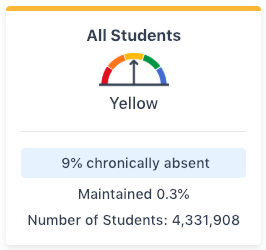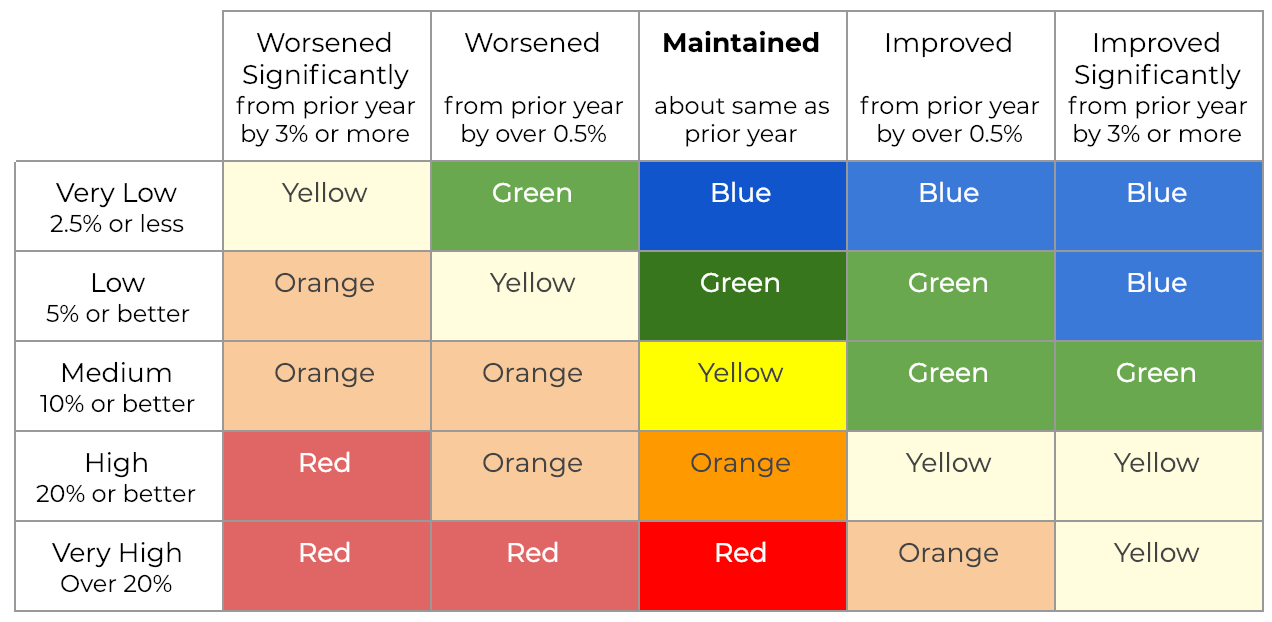Don't. Miss. School.

Attendance and Absenteeism
Showing up to school is the daily starting line for education. When kids miss school it's a warning sign of bad outcomes down the road. Because attendance matters so much, the school finance system is designed with powerful incentives to encourage it. School districts receive funds only for the students who show up. When kids miss out on school, school districts miss out on funding. Attendance records are audited.
Get chronic absenteeism data for your school by grade level on EdSource
When a student misses school more than 10% of the time, he or she is said to be chronically absent. The California School Dashboard includes an indicator that focuses on chronic absences among the 4.3 million students in grades K through 8. In 2017-18, about 9% of them were chronically absent, slightly worse than the prior year:

An ordinary school year in California is 180 days, so the typical threshold for chronic absenteeism is 18 days. In the 2017-18 school year nearly 400,000 students in California were chronically absent, each missing more than two and a half weeks of school.
As with all indicators on the dashboard, the color is determined using cut-points set by the California State Board of Education. If the percentage of kids who are chronically absent remains the same as the prior year (changing less than one half of a percentage point) the color of the dashboard remains the same.
Below are the colors if the level of chronic absence is stable. For example, blue means that fewer than 2.5 percent of your students were chronically absent. Red is very bad news — it means that more than 20 percent were chronically absent. The basic cut-points are summarized below:

On the other hand, if the average chronic absentee rate at your school has changed by more than half a percentage point in the last year, the performance color might be bumped up or down a level or more. Remember, the Dashboard is based both on status and change. Here's the five-by-five reference table:

Significant change in the rate of chronic absence can significantly influence the performance color on the dashboard. For example, look at the bottom-right corner of the five-by-five table above. A chronic absenteeism rate of more than 20% is a real cause for concern, but if the rate is improving faster than 3% year-on-year, it might make better sense to celebrate and support progress than to take alarm. Instead of red, the performance color in this case is yellow.
When the Dashboard is being applied to a small school (or a small subgroup) of fewer than 150 students, the outer columns are combined with the inner ones. In this "three-by-five methodology" the dashboard shows whether chronic absenteeism got worse, stayed the same, or got better. By eliminating the nuance of by how much, this methodology avoids chopping up the data into groups too small to be displayed.
As always, the Dashboard's essential purpose is to help focus attention where it is needed. The point isn't just to look at it, but to use it as a starting place for improvement. Using the Dashboard can help you figure out which schools in your district are struggling with chronic absenteeism. Examine which student subgroups have low attendance and find out why. Going to the data can help reduce biases and make a difference.
Using Dashboard data, EdSource has created a search-and-compare tool to make comparisons easier.
Across the state, in 2017-18 chronically absent students missed more than seven million days of school, and their districts missed out on more than half a billion dollars in funding. Investments to improve attendance not only help students learn, they can pay for themselves because school districts receive more funds when students show up.
Updated Feb 2019
Context: Ed100 Lesson 9.7
Part 1: Overview
Part 2: The Indicators
Part 3: Performance Colors
Part 4: Math and English
Part 5: English Learners
Part 6: Attendance and Absenteeism
Part 7: Suspensions
Part 8: Graduation
Part 9: College and Career Success
Part 10: "Local" Indicators for School Districts
Tags on this post
Absences DashboardAll Tags
A-G requirements Absences Accountability Accreditation Achievement gap Administrators After school Algebra API Arts Assessment At-risk students Attendance Beacon links Bilingual education Bonds Brain Brown Act Budgets Bullying Burbank Business Career Carol Dweck Categorical funds Catholic schools Certification CHAMP Change Character Education Chart Charter schools Civics Class size CMOs Collective bargaining College Common core Community schools Contest Continuous Improvement Cost of education Counselors Creativity Crossword CSBA CTA Dashboard Data Dialogue District boundaries Districts Diversity Drawing DREAM Act Dyslexia EACH Early childhood Economic growth EdPrezi EdSource EdTech Education foundations Effort Election English learners Equity ESSA Ethnic studies Ethnic studies Evaluation rubric Expanded Learning Facilities Fake News Federal Federal policy Funding Gifted Graduation rates Grit Health Help Wanted History Home schools Homeless students Homework Hours of opportunity Humanities Independence Day Indignation Infrastructure Initiatives International Jargon Khan Academy Kindergarten LCAP LCFF Leaderboard Leadership Learning Litigation Lobbyists Local control Local funding Local governance Lottery Magnet schools Map Math Media Mental Health Mindfulness Mindset Myth Myths NAEP National comparisons NCLB Nutrition Pandemic Parcel taxes Parent Engagement Parent Leader Guide Parents peanut butter Pedagogy Pensions personalized Philanthropy PISA Planning Policy Politics population Poverty Preschool Prezi Private schools Prize Project-based learning Prop 13 Prop 98 Property taxes PTA Purpose of education puzzle Quality Race Rating Schools Reading Recruiting teachers Reform Religious education Religious schools Research Retaining teachers Rigor School board School choice School Climate School Closures Science Serrano vs Priest Sex Ed Site Map Sleep Social-emotional learning Song Special ed Spending SPSA Standards Strike STRS Student motivation Student voice Success Suicide Summer Superintendent Suspensions Talent Teacher pay Teacher shortage Teachers Technology Technology in education Template Test scores Tests Time in school Time on task Trump Undocumented Unions Universal education Vaccination Values Vaping Video Volunteering Volunteers Vote Vouchers Winners Year in ReviewSharing is caring!
Password Reset
Search all lesson and blog content here.
Login with Email
We will send your Login Link to your email
address. Click on the link and you will be
logged into Ed100. No more passwords to
remember!














Questions & Comments
To comment or reply, please sign in .